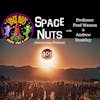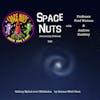#406: Celestial Choreography & Speedy Snapshots: Deciphering Distant Star Systems & The Challenge of Cosmic Photography

The eposode of Space Nuts is brought to you by NordPass....the password manager that will make your life so much eaier for not very much money. Check out our special offer at https://www.bitesz.com/nordpass - you'll be glad you did.
Strap in for an...
The eposode of Space Nuts is brought to you by NordPass....the password manager that will make your life so much eaier for not very much money. Check out our special offer at www.bitesz.com/nordpass - you'll be glad you did.
Strap in for an astronomical journey as Andrew Dunkley and Professor Fred Watson return to answer your burning cosmic questions in this enlightening episode of Space Nuts. Beam up to the cosmos as we tackle the challenges of snapping photos at supersonic speeds with the Breakthrough Starshot project. Viano from Florence brings into focus the hurdles of capturing clear images of distant planets when traveling at a third the speed of light. Could the blur of speed and the distortion of space-time leave us with just a glimpse of Proxima Centauri's secrets?
Next, we delve into the cosmic dance of celestial bodies. Brady from Florida, with a front-row seat to rocket launches, ponders the possibility of a moon having its own moon. Could a satellite's satellite exist, or are the gravitational tugs within our solar system too much for such a delicate balance? Professor Watson explains the intricate gravitational ballet that determines these cosmic relationships.
Then, Scott from Oregon opens a window into the fascinating world of triple star systems with a question about HD 110067. How can stars so far apart still be considered gravitationally bound? Discover the cosmic ties that bind these stellar companions across vast distances.
And for a bonus, we tackle an impromptu query from Dean about the Hubble Space Telescope's remarkable ability to maintain steady images while orbiting Earth. The secret lies in the dance of gyroscopes, but how long can this celestial photography session last?
From interstellar photography to the gravitational waltz of moons and stars, this episode is packed with insights into the mechanics of our universe. Remember to send us your space-related questions, and join us on this voyage of cosmic discovery. Subscribe to Space Nuts on your favorite podcast platform, and until our next stellar encounter, keep gazing at the stars and wondering about the wonders above.
📋 Episode Chapters
(00:00) Andrew Dunkley welcomes your questions for Space Nuts Q and A
(01:52) Riano from Florence in Italy has two questions for us
(04:13) Andrew: Breakthrough project aims to send micro spacecraft to Alpha Centauri
(10:06) I talked about pluto about 100 times, I think
(10:21) Viana raises doubts about whether taking pictures from space is feasible
(12:40) Vienna's question was about the orbits of planets
(14:06) Andrew Dunkley with professor Fred Watson on space nuts podcast
(18:05) Andrew Dunkley: Scott from Oregon questions distance of triple star system
(23:57) Fred Watson says Hubble's lifetime will eventually be limited because gyroscopes failed
Become a supporter of this podcast: https://www.spreaker.com/podcast/space-nuts--2631155/support.
New to Space Nuts?
Here are some great episodes to start with.







































